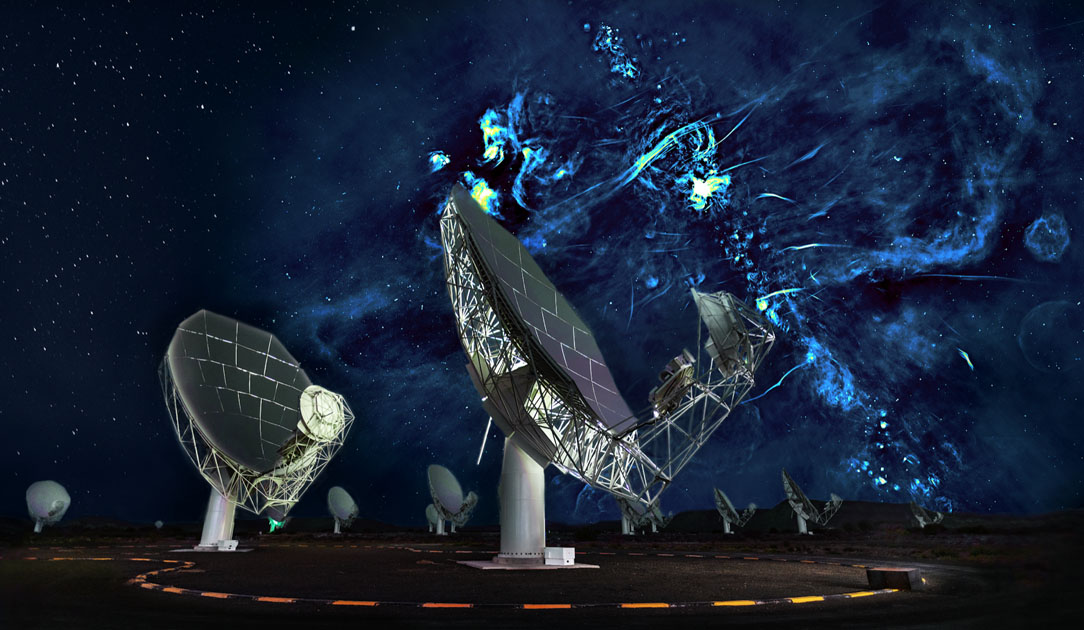
SA’s MeerKAT Telescope Discovers a Group of Galaxies
The South African Radio Astronomy Observatory (SARAO) announced on Tuesday that a group of 20 galaxies have been discovered with South Africa’s MeerKAT telescope. This large galaxy group is likely the most neutral hydrogen gas-rich group ever discovered, and it is the first time this group has been identified, despite residing in a very well-studied […]

The South African Radio Astronomy Observatory (SARAO) announced on Tuesday that a group of 20 galaxies have been discovered with South Africa’s MeerKAT telescope.
This large galaxy group is likely the most neutral hydrogen gas-rich group ever discovered, and it is the first time this group has been identified, despite residing in a very well-studied area of the sky.
SARAO said most star-forming galaxies are embedded within a cloud of cold neutral hydrogen gas, which acts as the raw fuel from which stars can eventually form.
This gas is extremely faint and can only be detected in radio wavelengths. It is diffuse and extends beyond the visible part of the galaxy.
By observing this hydrogen gas, astronomers are able to understand the evolutionary processes that take place in galaxies.
This “serendipitous discovery” has been published in the Monthly Notice of the Royal Astronomical Society.
The majority of galaxies in the universe reside in groups. However, it is rare to detect a group with such a large number of group members with so much neutral hydrogen. This suggests that the group is still in the process of assembly, as it has not undergone evolutionary processes that would remove this gas from the galaxies.
The paper on the discovery was led by Shilpa Ranchod, an MSc student supervised by Professor Roger Deane at the University of Pretoria.
“The distribution of neutral hydrogen gas in these galaxies has revealed interesting, disturbed morphologies suggesting that these galaxies are group members, and are being influenced by their cosmic neighbours in the group.
“For example, we found an interacting pair of galaxies that will potentially merge to form a new galaxy with a completely transformed appearance,” Ranchod said.
This galaxy group was discovered by the MeerKAT International Gigahertz Tiered Extragalactic Exploration (MIGHTEE) survey.
It is one of the large survey projects in progress with South Africa’s MeerKAT telescope and involves a team of South African and international astronomers.
The MeerKAT radio telescope in the Northern Cape, South Africa’s precursor to the Square Kilometre Array (SKA), aims to answer fundamental questions about the formation and evolution of galaxies. Its exceptional sensitivity provides astronomers with further insight into the drivers of galaxy evolution.
“This galaxy group sits in an area of sky that has been studied with many other telescopes, but only with MeerKAT is the group structure revealed so clearly.
“Galaxy environment strongly affects how galaxies change and grow, and observations of neutral hydrogen with MeerKAT give us a new observational window into structures like this,” said Dr Natasha Maddox, research scientist at Ludwig Maximilians Universität in Munich, and co-chair of the MIGHTEE neutral hydrogen working group.
“MeerKAT is an important step in the direction of the SKA – providing us with a view to future SKA science projects and lessons on how to overcome the many technical challenges involved in realising the true scientific potential of SKA and SKA pathfinders,” said Dr Bradley Frank, SARAO’s associate director of astronomy operations at the Inter-university Institute for Data Intensive Astronomy and co-chair of the MIGHTEE neutral hydrogen working group.
“This discovery shows that our MeerKAT observations caught a galaxy group in the early stages of its assembly, which is very uncommon.
“Therefore, this discovery is not only important per se, but will set new grounds for understanding of how galaxies are assembled into groups and transformed by their environment. We expect many wonderful findings like this in the future, thanks to the ongoing MeerKAT surveys,” said Dr Anastasia Ponomareva, researcher at the University of Oxford and co-author of the paper. – SAnews.gov.za